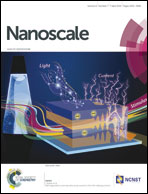A general quantitative pH sensor developed with dicyandiamide N-doped high quantum yield graphene quantum dots†
Abstract
A general quantitative pH sensor for environmental and intracellular applications was developed by the facile hydrothermal preparation of dicyandiamide (DCD) N-doped high quantum yield (QY) graphene quantum dots (GQDs) using citric acid (CA) as the carbon source. The obtained N-doped GQDs have excellent photoluminesence (PL) properties with a relatively high QY of 36.5%, suggesting that N-doped chemistry could promote the QY of carbon nanomaterials. The possible mechanism for the formation of the GQDs involves the CA self-assembling into a nanosheet structure through intermolecular H-bonding at the initial stage of the reaction, and then the pure graphene core with many function groups formed through the dehydration between the carboxyl and hydroxyl of the intermolecules under hydrothermal conditions. These N-doped GQDs have low toxicity, and are photostable and pH-sensitive between 1.81 to 8.96, giving a general pH sensor with a wide range of applications from real water to intracellular contents.


 Please wait while we load your content...
Please wait while we load your content...